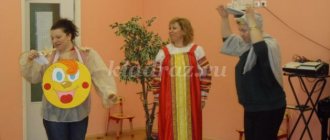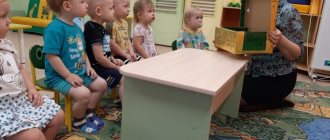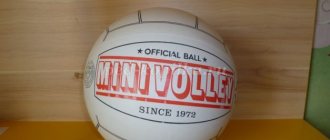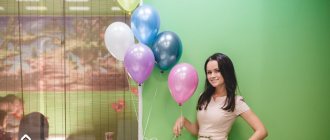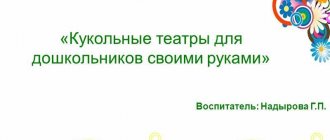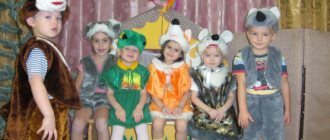"Whychki" circle Early age group
Circle
“Pochemuchki”
Early age group
Explanatory note
Of particular importance for the development of a preschooler’s personality is his assimilation of ideas about the relationship between nature and man. Mastering the methods of practical interaction with the environment ensures the formation of a child’s worldview and his personal growth. A significant role in this direction is played by the search and cognitive activity of preschoolers, which takes place in the form of experimental actions.
Children's experimentation is not an activity isolated from others. It is closely connected with other types of activities, and primarily with such as observation and work, speech development, visual activity, physical education; to a lesser extent, experimentation is associated with musical and physical education.
Experimentation acts as a teaching method if it is used to transfer new knowledge to children. It can be considered as a form of organization of the pedagogical process, if the latter is based on the method of experimentation. And finally, experimentation is one of the types of cognitive activity of children and adults.
Entertaining experiences and experiments encourage children to independently search for reasons, methods of action, and show creativity, as they are presented taking into account the current development of preschoolers.
It is rare that a child, regardless of age, during a game - classes, activities - quizzes, does not want to show independence, to be the first smart, knowledgeable, first, to be like an adult! In this sense, selected games and activities can significantly make the “children’s work” (game) joyful and desirable!
GENERAL TASKS OF ORGANIZING SEARCH AND COGNITIVE (EXPERIMENTAL) ACTIVITIES OF PRESCHOOL CHILDREN:
— formation of dialectical thinking in children, i.e. the ability to see the diversity of the world in a system of relationships and interdependencies;
— development of one’s own cognitive experience in a generalized form using visual aids (standards, symbols, conditional substitutes, models);
— expanding the prospects for the development of children’s search and cognitive activity by including them in thinking, modeling and transformative actions;
- maintaining children's inquisitiveness, initiative, intelligence, criticality, and independence.
The work is organized in 3 interrelated areas:
- Live nature
- inanimate nature
- Human
TASKS OF THE "WHY" CIRCLE (EXPERIMENTAL - EXPERIMENTAL ACTIVITIES) IN
THE I JUNIOR GROUP No. 5 "CAMOMILE":
1. To develop the ability to perform actions in accordance with the proposed pictogram. Determine the content of the activity.
2. To develop the ability to consider a phenomenon as a system, a set of stable connections between the components of the phenomenon along the line present - vulgar - future to identify the interconnections of objects of the man-made world (stump stool, chair) or living nature (egg - chicken - hen).
By the end of the year, children should be able to:
1. Perform actions in accordance with the suggested icon. Determine the content of the activity.
2. Consider a phenomenon as a system, a set of stable connections between the components of the phenomenon along the line present - vulgar - future to identify the interrelations of objects of the man-made world (stump-stool, chair) or living nature (egg - chicken - hen).
LITERATURE.
Veraksa N.E. Cognitive and research activities of preschoolers. M.2012
Dybina O.V. What are the objects made of? Games – activities for preschoolers. M.2013
Dybina O.V. The unknown is near. Experiences and experiments for preschoolers. M. 2013.
Dybina O.V. Man-made world: Scenarios of games and activities for preschoolers. M.2000.
Card index of experiences and experiments for children of primary preschool age.
Long-term work plan for the circle:
| October | |||
| 1 a week | “Let’s find out what kind of water it is?” | (identification of water properties) | O. V. Dybina "The unknown is nearby" p. 5 |
| 2 a week | "Ships" | (introduction to the properties of floating objects) | “Card index of experiences and experiments for young children” Topic: “Water” p.4, No. 1 |
| 3 a week | "Dives" | (introduction to the properties of “diving” toys) | “Card index of experiences and experiments for young children” Topic: “Water” p.4, No. 2 |
| 4 a week | "Foam" | (introduction to obtaining foam from shampoo) | “Card index of experiences and experiments for young children.” Topic: “Water” p.4, No.5 |
| November | |||
| 1 a week | “How to see the air?” | (detection of air in the surrounding space) | O.V. Dybina "The unknown is nearby" p. 6 |
| 2 a week | "Games with a balloon and a straw" | (detection of air in the surrounding space) | O.V. Dybina "The unknown is nearby" p. 7 |
| 3 a week | "The wind blows across the sea" | (detection of air in the surrounding space) | O.V. Dybina "The unknown is nearby" p. 8 |
| 4 a week | "Blowing Soap Bubbles" | (detection of air in the surrounding space) | O.V. Dybina "The unknown is nearby" p. 8 |
| December | |||
| 1 a week | "What is in the box?" | (familiarity with the meaning and source of light) | O.V. Dybina "The unknown is nearby" p. 9 |
| 2 a week | "Magic brush" | (introduction to obtaining intermediate colors) | O.V. Dybina "The unknown is nearby" p. 9 |
| 3 a week | "Light heavy" | ( determining the weight of objects and grouping them by weight) | O.V. Dybina "The unknown is nearby" p. 10 |
| 4 a week | “What does it sound like?” | (identifying an object by the sound it makes) | O.V. Dybina "The unknown is nearby" p. eleven. |
| January | |||
| 1 a week | —————— | —————- | —————- |
| 2 a week | "Snow Town" | (introduction to the properties of snow) | “Card index of experiences and experiments for young children.” Topic: “Snow” p.6, No. 3 |
| 3 a week | “Making colored ice floes” | (identification of water quality) | O.V. Dybina "The unknown is nearby" p. 5 |
| 4 a week | “Different feet stomp along the snowy path” | (getting clear tracks in the snow) | “Card index of experiences and experiments for young children.” Topic: “Snow” p.6, No. 1 |
| February | |||
| 1 a week | "Hot - cold" | (determination of the temperature qualities of objects and substances). | O.V. Dybina "The unknown is nearby" p. 12 |
| 2 a week | "Onion is our friend" | (short-term project) | |
| 3 a week | "Onion is our friend" | (short-term project) | |
| 4 a week | "Magic Magnet" | (introduction to a magnet and its properties) | “Card index of experiences and experiments for young children.” Topic: “Magnet” p.12, No. 1 |
| March | |||
| 1 a week | "Sunny bunnies" | (introduction to the properties of sunlight) | “Card index of experiences and experiments for young children.” Topic: “Sun” p.13, No. 1 |
| 2 a week | "Shadow" | (introduction to the properties of sunlight) | “Card index of experiences and experiments for young children.” Topic: “Sun” p.13, No. 2 |
| 3 a week | "Colorful Glasses" | (introduction to the properties of transparent glass) | “Card index of experiences and experiments for young children.” Topic: “Sun” p.13, No. 3 |
| 4 a week | "My Green Hair" | (introduction to the properties of sunlight) | “Card index of experiences and experiments for young children.” Topic: “Plants” p.16, No. 4 |
| April | |||
| 1 a week | "Teremok" | (introduction to the properties of wood) | O.V. Dybina “What are objects made of”, p.9, No. 2. |
| 2 a week | "Ducklings" | (introduction to the properties of paper and fabric) | O.V. Dybina “What are objects made of”, p. 13, No. 1. |
| 3 a week | "Gifts for Little Bear" | ( recognition of objects made of fabric, paper, wood using material characteristics) | O.V. Dybina “What are objects made of”, p. 20, No. 1. |
| 4 a week | "Visiting Little Red Riding Hood" | ( consolidating children's knowledge about materials) | O. V. Dybina “What are objects made of”, p. 21, No. 1. |
CLASS WORK PLAN 2018-2019
TASKS OF THE CLUB “WHY” (EXPERIMENTAL – EXPERIMENTAL ACTIVITIES) IN
THE II JUNIOR GROUP No. 5 “CAMOMILE”:
TASKS OF THE CLUB:
- Learn to build buildings from sand using natural materials: stones, branches, cones, leaves.
- Learn to catch balls from the water using a net.
- Learn to perform washing techniques and sequence correctly.
- Teach your child to wash the table.
- Learn to collect water from the table with a sponge.
- Learn to determine by ear experimentally that the sound when hitting the glass depends on the amount of water in the glass.
- Reinforce knowledge about the properties of water.
- Develop control and coordination of movements.
- Learn to measure volume (capacity).
- Introduce the concepts of quantity and counting.
- Develop social behavior skills.
- Develop: independence, accuracy, fine motor skills of the hands and wrists.
- Learn to distinguish, group, prepare for creativity.
LITERATURE.
T.N. Fedoseeva. Methodical instructions “Games and activities with water and sand.”
“School for kids. For the very little ones”, 144 - 97. Montessori home school.
“Exercises with Montessori materials.”
K. Belaya. “Step by Step” p. 151.
Recommendations of the “Step by Step” program - Games with water and sand.
Long-term work plan for the circle:
SEPTEMBER
| A WEEK | THE CONTENT OF THE WORK | MATERIAL |
| I GAMES WITH WATER | Exercise “Floating floating toys on the water.” Objectives: to give children the idea that objects float; about numerical determination - one and a lot of. Source: T.N. Fedoseeva. Methodical instructions “Games and activities with water and sand.” | A basin of water, rubber and plastic toys, a towel. |
| II GAMES WITH SAND | Exercise “Let’s sprinkle the paths.” Tasks: Learn to sprinkle cereals and sand with three fingers. Source: magazine “School for Kids. For the very little ones”, 144 - 97. Montessori home school. | A deep saucer with cereal - semolina or millet. |
| III GAMES WITH WATER | Exercise “Still water in . | A basin filled with water, a towel. |
| IV GAMES WITH SAND | Exercise "Spooning" Objectives: Learn to pour grains with a spoon, analyze complex movements, remember the sequence of actions. Source: magazine “Preschool Education” No. 10 - 2000, p. 57. Montessori home school. | 2 bowls on a tray, the left one is filled with peas, grains or rice, a spoon. Bowls are the same size. |
OCTOBER
| A WEEK | THE CONTENT OF THE WORK | MATERIAL |
| I GAMES WITH WATER | Exercise ''Catching toy fish with nets.'' Objectives: Learn to catch fish with a net from a basin. Source: ''School for kids''. Exercises with Montessori material, p. 157. | A bowl of water, nets, plastic fish. |
| II GAMES WITH SAND | Exercise "Magic sieve". Objectives: Learn to separate small grains from large grains using a sieve. Source: magazine “for the very little ones” No. 4 - 97. Montessori home school. | Sieve, semolina and rice (half a glass each), plates, spoon. |
| III GAMES WITH WATER | Exercise "Pouring from a teapot into a cup." Objectives: Learn to pour water from a kettle into a cup. Source: “School for Kids”. Exercises with Montessori materials. | Tray, teapot, cup, sponge. |
| IV GAMES WITH SAND | Exercise “Collect all the beads.” Objectives: Learn to separate beads from sand using a sieve. Source: magazine “for the very little ones” No. 4-97. Montessori home school. | Sieve, scoop, small beads, sand, plate. |
NOVEMBER
| A WEEK | THE CONTENT OF THE WORK | MATERIAL |
| I GAMES WITH WATER | Exercise "Whipping foam." Objectives: Learn to whip foam with a whisk, develop the muscles of the hand. Source: "School for Kids". Exercises with Montessori materials, p. 158. | Bowl with Water, liquid soap, sponge, tray. |
| II GAMES WITH SAND | Exercise “Sweep, but don’t wake up.” Objectives: Learn to clean up after yourself, sweep off the table using a brush and dustpan. Source; magazine “for the little ones”, Md 4-97. Montessori home school. | Brush, dustpan. |
| III GAMES WITH WATER | Exercise “Launching boats on the water.” Objectives: to give an idea that boats float. Source: T.N. Fedoseeva, Methodological instructions. “Games and activities with water and sand.” | A basin of water, boats. |
| IV GAMES WITH SAND | Exercise ''Sprinkling grains from jug to jug.” Objectives: Learn to pour grains from jug to jug, analyze complex movements. Source: magazine “Preschool Education” N2 10 - 2000, p.58. Montessori home school. | 2 small jugs of the same shape (milk jug type). |
DECEMBER
| A WEEK | THE CONTENT OF THE WORK | MATERIAL |
| I GAMES WITH WATER | Exercise “Pouring water through a funnel.” Objectives: Learn to pour water through a funnel into a bottle. Source: “School for Kids”. Exercises with Montessori material, p. 153. | Jug of Water, funnel, bottle. |
| II GAMES WITH SAND | Exercise “Pushing pebbles and small objects out of sand by shaking.” Objectives: Learn to separate pebbles from sand. Source: Recommendations from the “Step by Step” program - Games with water and sand. | Sand with pebbles, deep cup, bucket. |
| III GAMES WITH WATER | Exercise “Shaking drops from wet hands onto paper.” Objectives: To consolidate knowledge of the properties of water. Source: K. Belaya. “Step by Step” p. 151. | Cup with water, sheet of paper, watercolor. |
| IV GAMES WITH SAND | Exercise “Sifting the Sand.” Objectives: Learn to separate pebbles from sand. Source: magazine “for the very little ones” No. 4—97. home - Montessori school. | Sieve, scoop, pebbles, sand, plates. |
JANUARY
| A WEEK | THE CONTENT OF THE WORK | MATERIAL |
| I GAMES WITH WATER | Exercise “Snowflake visiting the guys.” Objectives: To consolidate knowledge of the properties of snow, the properties and qualities of water, Source: K. Belaya. “First steps” p. 158.— 161. | Cups with water and snow. Vessels with clean water. Paint, glasses for experiments. Drinking glasses. Paper snowflakes. |
| II GAMES WITH SAND | Exercise "Sand Coloring" Objectives: Learn to rub with colored marks between your palms. Source: Recommendations from the Step by Step program. "Playing with water and sand." | Sand, crayons, plates, scoop. |
| III GAMES WITH WATER | Exercise “Gather water in your palms, passing it through your fingers, or holding it in tightly clenched hands.” Objectives: To consolidate knowledge of the properties of water. Source: 'Step by Step' program recommendations. | Basin with water. |
| IV GAMES WITH SAND | Exercise ''Filling transparent containers with layers of colored sand.” Objectives: Learn to pour sand in layers, trying not to mix the layers, work carefully. Source: Recommendations from the Step by Step program. | Colored sand in plates, a transparent container, a scoop. |
FEBRUARY
| A WEEK | THE CONTENT OF THE WORK | MATERIAL |
| I GAMES WITH WATER | Exercise “Onion in water.” Objectives: Learn to plant onion bulbs. Source: “School for Kids”. Exercises with Montessori, p. 154. | 3-4 transparent glasses, 3-4 large onions, a jug of water. |
| II GAMES WITH SAND | Exercise “Pour dry sand through a funnel.” Objectives: To consolidate children’s knowledge about the properties of dry and wet sand, Source: T.N. Fedoseeva. Methodical instructions. "Games - activities with water and sand." | Dry sand, buckets, bottles, funnels, molds. |
| III GAMES WITH WATER | Exercise “Blowing soap bubbles.” Objectives: Learn to exhale air carefully, achieving a bubble. Source: T.N. Fedoseeva. Methodical instructions. "Games - activities with water and sand." | Soap foam on a saucer, straws. |
| IV GAMES WITH SAND | Exercise “Building a sand house for a bunny.” Objectives: to give an idea of dry and wet sand: dry sand crumbles, wet sand is lazy. Source: K. Belaya. “First steps”, p.150. | Container with dry sand, water V jug, bunny. |
MARCH
| A WEEK | THE CONTENT OF THE WORK | MATERIAL |
| I GAMES WITH WATER | Exercise "Transferring the balls." Objectives: Learn to catch balls using a strainer. Source: “School for kids. For the very little ones,” No. 4—97. Montessori home school. | A basin of water, plastic balls, strainers. |
| II GAMES WITH SAND | Exercise “A treat for mother’s holiday.” Objectives: To consolidate knowledge of the properties of sand. Source: K. Belaya. “First steps”, p.152. Materials of the Moscow city competition (model of early childhood education) 2001 - 2002. | Sand, pebbles, twigs, leaves. |
| III GAMES WITH WATER | Exercise “Collecting Water with a Sponge.” Objectives: Learn to clean up after yourself (collect water with a sponge, squeezing it over a basin) Source: magazine “for the very little ones”, No. 4-97. Montessori home school, p. 12 | Two plates, a sponge. |
| IV GAMES WITH SAND | Exercise “Drawing with a stick in the sand.” Objectives: Develop arm muscles and coordination of their movements. Expand visual perception. Source: T.N. Fedoseeva. Methodical instructions “Games and activities with water and sand.” | Damp sand, sticks. |
APRIL
| A WEEK | THE CONTENT OF THE WORK | MATERIAL |
| I GAMES WITH WATER | Exercise “Washing the table.” Tasks: Teach the child to wash the table. Source: “School for Kids”. Exercises with Montessori materials, p. 1 60. | Jug of water, 2 bowls, soap, sponge, rag, bucket, | apron, hand towel. |
| II GAMES WITH SAND | Exercise “We are building a tower.” Objectives: Learn to build a tower out of sand, strengthening it with pebbles. Reinforce knowledge of the properties of sand. Source: K. Belaya. “First steps”, p. 152. Materials of the Moscow city competition (model of early childhood education) 2001 - 2002. | Sand, pebbles, flag. |
| III GAMES WITH WATER | Exercise "Wash". Objectives: Learn to correctly perform washing techniques and sequence. Source: “School for Kids”. Exercises with Montessori materials, p. 160. | 2 basins, soap dish with soap, jug, apron, doll linen, clothespins, bucket, floor cloth. |
| IV GAMES WITH SAND | Exercise “What I buried in the sand.” Objectives: Develop attention, memory, observation. Source: T.N. Fedoseeva. Methodical instructions. “Games - activities with water and sand.” | Sand, 3 story toys. |
MAY
| A WEEK | THE CONTENT OF THE WORK | MATERIAL |
| I GAMES WITH WATER | Exercise “Ringing water.” Objectives: Determine experimentally that the sound when hitting a glass depends on the amount of water in a glass. Source: “School for Kids”. Exercises with Montessori material, p. 161. | A set of various glasses filled to the middle with water, a stick. |
| II GAMES WITH SAND | Exercise “House for the turtle Agashka.” Objectives: To consolidate the ability to manipulate dry and wet sand. Learn to use different shapes of stones. Source: K. Belaya. “First steps”, p.152. Materials of the Moscow city competition 2001-2002. | Sand, basins of water, ; pebbles. |
| III GAMES WITH WATER | Exercise “Painting water with watercolors.” Objectives: To consolidate knowledge about the properties of water. | Set of watercolor paints, cups With water, brush. |
| IV GAMES WITH SAND | Exercise “Laying out various shapes from raw sand using molds.” Objectives: To reinforce the properties of raw sand in children. Source: T.N. Fedoseeva. Methodical instructions “Games and activities with water and sand.” | Wet sand, scoops, molds. |
TASKS OF THE “WHY” CIRCLE (EXPERIMENTAL – EXPERIMENTAL ACTIVITIES) IN MIDDLE GROUP No. 5 “CAMOMILE”:
Program for the “Umnichka” circle for children 2-3 years old
Material:
ready-made tie template made of cardboard, multi-colored stars made of colored paper.
4 week
Topic: "Magic pasta."
Goals:
teach children to string pasta on a thread, develop fine motor skills.
Material:
pasta with a large hole, thread.
March
1 Week
Topic: “Gift for Mom” (applique).
Goals:
teach children to decorate a basket with lumps of crumpled paper of different colors; consolidate gluing techniques.
Material:
a cardboard basket and lumps of crumpled paper of different colors.
2 week
Topic: “Magic strainer” (sifting cereals through a sieve).
Goals:
introducing children to cereals; teach children to sift cereals through a sieve; develop fine motor skills of the hands.
Material:
cereal, sieve.
3 week
Topic: "Dexterous hands."
Goals:
continue to teach children how to button and unfasten buttons, lace and unlace, and fasten a lock; development of attention, perseverance, fine motor skills.
Material:
lacing, boot, zipper, shirt.
4 week
Topic: “Mand your clothes.”
Goals:
teach children to insert objects of different shapes into the corresponding holes, fix the size and color of 4 primary colors.
Material:
cardboard, tape.
April
1-2 week
Topic: “Buds and leaves” (drawing + application).
Goals:
mastering visual and expressive means to convey the transformation of an image: drawing a branch with buds and gluing leaves.
Material:
album sheets, gouache, cut out leaves from colored paper.
3 week
Topic: “Treating the bear (livers and gingerbread)” (modeling).
Goals:
continue to teach children how to roll out a ball and lightly flatten it into a disk to make cookies and gingerbread; development of a sense of form and fine motor skills.
Material:
plasticine.
4 week
Topic: “Put a ball, a kinder egg” in your house.”
Goals:
pay attention to the color of objects, group homogeneous objects by color, learn to compare dissimilar objects by color, consolidate primary colors.
Material:
egg trays painted red, yellow, blue, green; plastic balls of the same color, collected in a bag.
May
1-2 week
Topic: “Let’s release the fish into the aquarium” (team work - application).
Goals:
teach children to engage in collective activities; navigate on a sheet of paper; consolidate gluing techniques.
Material:
a sheet of whatman paper, cut out fish from colored paper, glue.
3-4 week
Topic: “Visiting toys.”
Goals:
continue to teach children, when comparing two objects, to highlight the parameters of width (wider - narrower) and height (higher - lower), to find similarities and differences; develop fine motor skills of the fingers; to form spatial-imaginative thinking; fix the color.
Material:
blue paper imitating a stream; two boards - short and long; paper flowers and butterflies in six colors; toy - bull; Tanya doll; toy - car, toy wheels of different sizes; toy - bear; two cots of different sizes.
